|
Home
What's New
Rangefinders
Fixed Lens
SLR
TL & DTL
XTL &
X-1000
MSX & DSX
NC1000
Z-Series
Other
Mamiya 35mm
Instruction
Manual
Reprints
Related
Links
Mamiya
35mm Camera
Auction
Prices
Mamiya
SLR Lenses
Auction
Prices
The Rest
of My
Collection
FAQ
|
Mamiya Prismat Information
The Mamiya Prismat series was remarkable in many ways.
One model of the camera was Mamiya's first SLR, while another model was their
first leaf-shutter SLR. Indeed, the rugged camera was even created in a model
used by Nikon, with the famous Nikon F-mount. It is my understanding Mamiya
even made at least two lenses for Nikon, which can be identified by their
markings as Nikkorex lens Sekor. All Gentle Readers with information are
actively encouraged to send me
an
email!
|
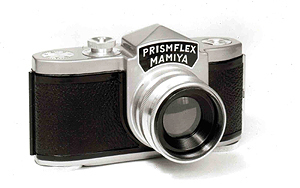
ABOVE: Mamiya Prism Flex, c.1952,
the
first Mamiya SLR Prototype
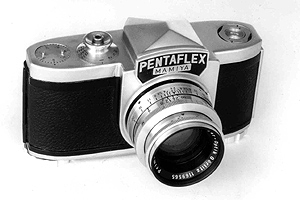
ABOVE: Mamiya Pentaflex, c.1955,
the
second Mamiya SLR Prototype
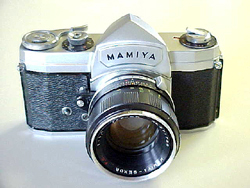
ABOVE: The first Mamiya Prismat
c.1961
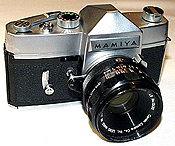
ABOVE: Mamiya Prismat NP c.1961
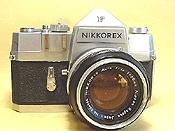
ABOVE: Nikkorex F
made by Mamiya
c.1962

ABOVE: Tower 32A
a re-branded
Prismat NP c.1963
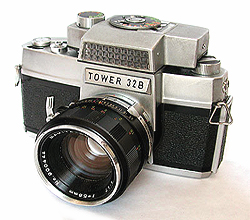
TOWER (Mamiya) 32B, with optional clip-on exposure meter |
Prototype Mamiya SLR
 New information
and pictures from Mamiya Japan indicate there were two Mamiya prototype
SLR models that preceded the Mamiya Prismat, making Mamiya one of the early
developers of the 35mm SLR! New information
and pictures from Mamiya Japan indicate there were two Mamiya prototype
SLR models that preceded the Mamiya Prismat, making Mamiya one of the early
developers of the 35mm SLR!
It is accepted historical fact that the odd-looking Russian GOMZ Sport
(c.1935) was the first 35mm SLR. Ihagee, a Dutch company totally destroyed in
WWII, had introduced the Kine-Exakta 35mm SLR in 1936. Neither of these
innovative cameras, however, used a pentaprism. The honor of being the first
pentaprism SLR is generally acknowledged to have been the Zeiss Ikon Contax
S (c.1949-50).
 

ABOVE: GOMZ Sport (c.1935),
Ihagee Kine-Exakta (c.1936), and Contax S (c.1950)
However, Mamiya was not far behind. In October 1951, the Japanese Ministry of
International Trade and Industry (MITI), obviously understanding the innovation
the SLR would bring to the camera industry, contributed the very large (at the
time) sum of 600,000 yen to assist Mamiya in the development of their own
single lens reflex camera.
The Mamiya Prismflex prototype was available by 1952. The second
prototype, the Mamiya Pentaflex was created in early 1955. My research
into how many were produced of each prototype - and the specifics of their
construction - is not yet complete, but Mamiya innovation is clear.
In truth, Mamiya beat most of their competition to everything but the market.
Asahi did not release their first Pentax model until 1957. Minolta's SR-2 was
not released until 1958. The Canonflex was not released until 1959, as was
Nippon Kogaku's Nikon F which, as we all know, quickly cornered the market. Why
Mamiya did not enter the SLR market with the Prismat until 1961 is an open -
and intriguing - question, since they had clearly been working on 35mm SLR
development for at least the previous 10 years.
Mamiya Prismat NP
The Mamiya Prismat NP, released in February 1961, was (by a few months)
Mamiya's first production single-lens reflex (SLR) 35mm. The very first Prismat
is readily identifiable by its distinctive curved nameplate on the front of
the prism housing. It was soon updated to the more familiar rectangular Mamiya
nameplate. It has no meter, and features a semi-automatic aperture with an
external linkage for aperture function.
The lens-cocking mechanism serves as a depth-of-field
preview device. The horizontal cloth focal-plane shutter has speeds from
1 to 1/1000, plus B and T. It also features FP and X sync receptacles and a
self timer. Typically equipped with a Mamiya FC 58mm f/1.7 lens, other manufacturers
also made lenses for the Mamiya NP.
A version was marketed through Sears as the Tower 37 (c.1961).
It was also marketed as the Mamiya Prismatic (c.1962 in the
UK), or the Mamiya Reflexa (c.1963), two of several Mamiya
35mm SLR cameras sold with Canon lenses in an Exacta-bayonet mount.
I have not yet found any definitive information concerning the exact
lenses Mamiya manufactured for this camera body, but there were
a great many other third-party lenses available that would fit the
Exacta mount.
The Prismat NP was also sold (c.1963) through Sears, as the Sears
32A and later the Tower 32B and Sears 32B. They
featured an optional clip-on exposure meter which fits over the
prism and coupled to the shutter speed dial. A version of the NP
with a vertical-travel, metal focal plane shutter was also sold
as the Sears SLII.
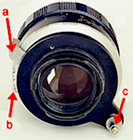 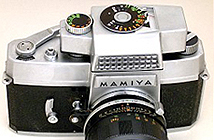
Aperture mechanism, 58mm MAMIYA F.C. f/1.7 lens (left); clip-on exposure meter
(right)
Mamiya produced a camera similar to the Prismat NP for Nikon, using a standard
Nikon F lens mount. It was introduced as the Nikkorex F in 1962.
It was the first camera fitted with the new metal Copal S vertical-travel focal
plane shutter, beating the Nikkormat from Nikon by a full three years. The
Nikkorex F, in good working order, is very much sought after today. A version
of it was marketed in Germany as the Nikkor J. Later, this same
camera from Mamiya can be seen in the Nikon-mount Ricoh Singlex.
Click Here for more information from the Nikon
Historical Society!
Mamiya also made the Nikkorex Zoom 35 for Nikon (not pictured).
It featured a non-interchangeable 43-86mm f/3.5 Nikkor Auto Zoom
lens. It had a Porro-mirror reflex finder and a coupled selenium
meter.
Click Here
for a table of known Mamiya NP clones.
|
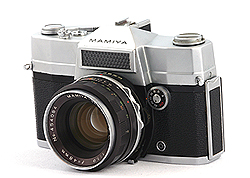
ABOVE: Mamiya Prismat PH c.1961
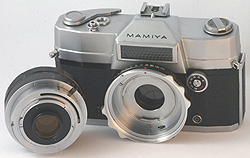
ABOVE: The truly unique Prismat PH bayonet
mount
BELOW: The equally unique mount
of the Prismat CPH
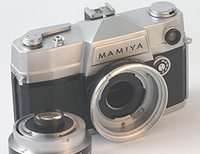 |
Mamiya Prismat PH
Released in July 1961, the Prismat PH, pictured at
left, was Mamiya's first leaf-shutter 35mm SLR (the Prismat NP, seen above,
was their first SLR). The shutter was built into the camera body, not the
lens.
The Prismat PH has a selenium-cell meter mounted
on the front of a fixed prism, and features a Seikosha-SLV behind-the-lens
leaf shutter with speeds from 1 to 1/500. The shutter-speed dial
is on the front of the body, and the camera came standard with a
48mm f/1.9 interchangeable bayonet-mount lens.
There is little available information about it,
but a version of the Mamiya PH (below), known as the Mamiya CPH,
(c.1963) was produced with a round CdS meter positioned on the camera
face, just below the rewind knob.
Yet another version of the Prismat PH, without the selenium cell or
CdS meter, was sold through Sears as the Tower 37 (c.1961).
All versions had a truly unique bayonet-mount. All versions are
also rare today in working order, and are considered a nice prize
by Mamiya collectors.

ABOVE: MAMIYA Prismat
CPH, with CdS meter
|
ABOVE: Prismat CWP c. 1964
CLICK HERE
for CWP (CP)
lens & accessory
information
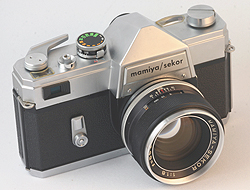
ABOVE: Mamiya CWP meter
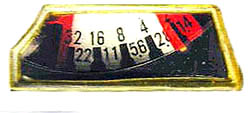
ABOVE: MAMIYA CWP meter |
Mamiya CWP
The Mamiya CWP was introduced in August 1964.
The CWP designation was used exclusively in the USA. Elsewhere it
was known as the Mamiya CP. It could have either Mamiya
or Mamiya/Sekor body nameplates.
It came with a 58mm f/1.7 thread-mount (42mm) Mamiya-Sekor lens,
with a fully automatic aperture. It had a CdS exposure meter on the front
plate. The meter is not coupled to the diaphragm and, rather than reading
through the lens, the metered f-stop is viewed in a small window
on top of the camera. The meter was originally powered by a 1.3v
PX625 mercury battery (mercury batteries are no longer available).
Usable replacement batteries are the 1.5v A625PX alkaline battery
or the Z625PX zinc-air battery, which can both be
purchased online.
With synch for both bulb and electronic flash, it has a horizontal
cloth focal-plane shutter with speeds from 1 to 1/1000; a self-timer;
and came with a full complement of optional, interchangeable lenses.
A rugged and dependable camera, the CWP is still found today, although
working models are becoming increasingly rare, and bring a reasonably
good price.
|
|












 New information
and pictures from Mamiya Japan indicate there were two Mamiya prototype
SLR models that preceded the Mamiya Prismat, making Mamiya one of the early
developers of the 35mm SLR!
New information
and pictures from Mamiya Japan indicate there were two Mamiya prototype
SLR models that preceded the Mamiya Prismat, making Mamiya one of the early
developers of the 35mm SLR!





